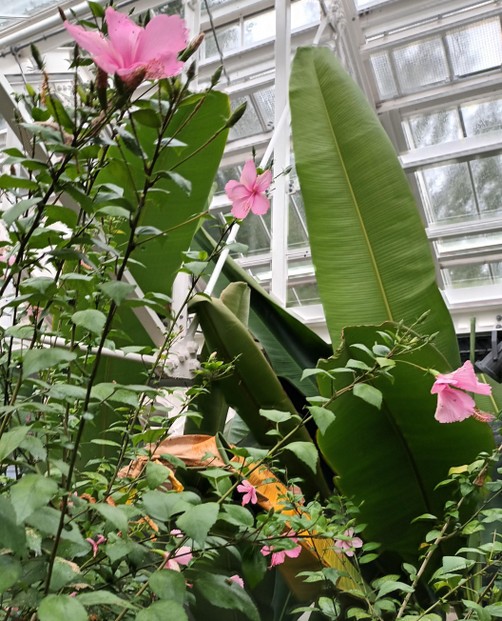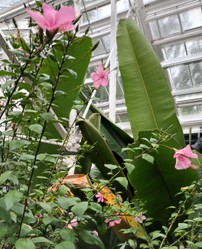There are countless different types of roses, so numerous that it takes an expert to know them all, if indeed anyone, even among experts has the knowledge of all types. So I am beginning this article with an account of how plants are classified, for understanding the botanical nomenclature will assist in understanding the plant's name. For the sake of brevity I will focus on the smaller categories.
While plants all have common names, all of them have scientific titles, and this rose is Rosa x hiberica. This locates it in the genus Rosa, a member of the enormous plant family known as the Rosaceae, which contains a huge proliferation of species and plenty of genera. The genus Rosa, like other genera [plural of genus] consists of a large range of closely related species. Species within a genus are closely related enough to interbreed, and often, though not always the hybrids are fertile. Note that Rosa hibernica capitalises the genus' name, but uses lower case for the species' name. This is normal botanical nomenclature. However, the insertion of an x between the two names indicates that it is a hybrid between two species within a genus; an x before the genus' name indicates an intergeneric hybrid, i.e. between species of different genera. These are usually infertile. If you see var followed by a name, e.g ....hibernica var. glabra, this indicates a distinction of a type within a species. A species name followed by a non-latin name in speech marks denotes a cultivar, which is a variety created and propagated by humans by vegetative propagation rather than by seed. I have not heard of any cultivars of the Irish Rose.
Hybridisation is common among wild plants, as plant seeds are no respecters of biological categories. Rosa hibernica is a cross between Rosa pimpinellifolia, the Burnet Rose, and Rosa canina, the dog rose. There may also be genes from native Irish wild roses that have over millennia contributed their share to hibernica's genetics. Sexual reproduction has the problem that desired varieties or species cannot breed true, as both parents contribute to the plant's genetics. This means that if you want to breed a true copy of the desired variety you must use asexual reproduction, known as vegetative propagation. There are several ways of doing this, but they vary from plant to plant. Roses are propagated by cuttings, so a cutting of Rosa hibernica would have been taken [probably several of them] and grown on in favourable conditions.
Rosa hibernica belongs to the group known as shrub roses, which means that they are in effect small trees. It can reach nine feet tall. The claim that Rosa hibernica only grows in Ireland is false. The same hybridisation has occurred independently in other parts of the British Isles, though rarely. The variety glabra was once thought to belong to hibernica, but has now been shown by genetic analysis to be a different hybridisation. Modern genetics has provided a great tool for analysing lines of descent.
Templeton's Rose is pink in colour and its flowers are followed in winter time by bright red hips. specimens are available for purchase from a small selection of plant nurseries.








 Pilgrimage. A reviewon 06/15/2025
Pilgrimage. A reviewon 06/15/2025
 Leo the Fourteenthon 05/09/2025
Leo the Fourteenthon 05/09/2025
 The Melsonby Hoardon 03/25/2025
The Melsonby Hoardon 03/25/2025



Comments
No, it is a help to tourists,to show which historic.person once dwelt there.
Thank you for your comment below, in answer to my previous observation and question.
Blue-plaque honors intrigue me.
Is the blue plaque the highest heritage honor or is it the only heritage-site honor.
As it is a heritage site I believe that it will have a blue plaque.
Does that mean that Cranmore is blue plaqued?
The Dictionary of Irish biography fits Cranmore into the Templeton legacy. It indicates it as a Royal Belfast Academical Institution possession on the latter's "playing fields, off Malone Road, south Belfast" and as a 21st-century conservation project of the Environment and Heritage Service of the Department of the Environment in Northern Ireland.
Blue plaques only go on the houses once inhabited by famous people. So there must have been special recognition to preserve the rose.l think that moving so well established a plant must have been a major project.Just think of what a hole must have been dug to get the roots out, and how much tending by expert gardeners followed the replanting.
Wonderful research, Deddriù. We have in the UK legislation to protect heritage sites.I don't know if the blue plaque system was operating in1954,but the road crew would have been directed to preserve the site. We have in the UK a system of planning permission for major projects.
The page Rosa canina x pimpinellifolia (R. x hibernica) Templeton - rose - Rosaceae on the Flora of Northern Ireland component of the habitas site describes "One of the shrubs" discovered by John Templeton as lasting on a Holywood-area road in County Down into the 1950s! The shrub had to be removed because of road-widening around 1954. It nowadays is seen in Belfast Botanic Gardens!
Apart its being on a particularly historic stretch or its being so fetching as to attract besotted admiration and desperate attempts to preserve or take for one's own, it would seem unusual to me that the road crew would have done anything other than clear-cut vegetation present where they wanted their road!
Would there have been a sign -- perhaps Please remove me to the Belfast Botanic Gardens if you have to do anything here that affects my growth ;-D -- that would have alerted the project developers or the road crew to the Templeton shrub?
There are other seed banks in the world as well as Kew. The more the merrier.
Hopefully,but cuttings are the way to grow hybrids.
There are a few nurseries that have them,and all derive from cuttings of the original.